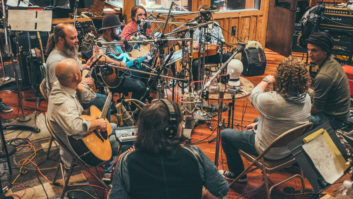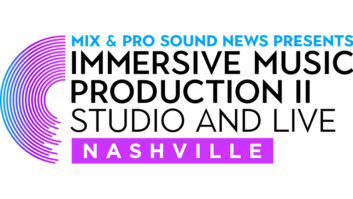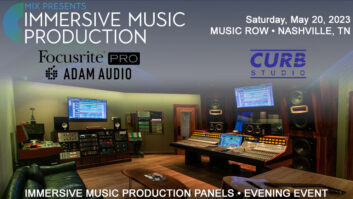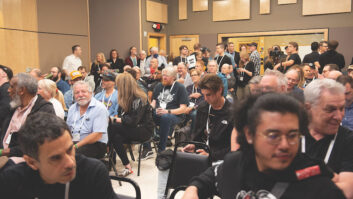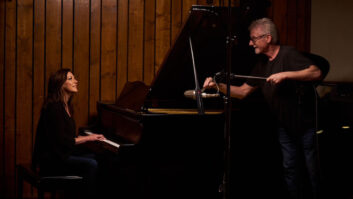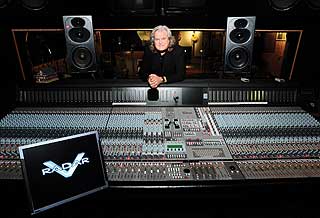
Country/bluegrass virtuoso Ricky Skaggs at the Amek/Neve 9098 console in his Skaggs Place Recording Studio
Ricky Skaggs’ fascination with recording studios began in the late 1970s, when he joined Emmylou Harris’ Hot Band and began studying the techniques of Harris’ producer, Brian Ahern.
“I saw his microphone collection and saw how he got sounds, but when I started working in Nashville studios, I didn’t see many microphones like the ones Brian had,” says Skaggs, who now owns and operates Skaggs Place Recording Studio in Hendersonville, Tenn. “Any time I saw a good mic or good gear, I’d try and buy it. The Quonset Hut [the studio where Johnny Cash, Bob Dylan and many others recorded] wound up going out of business in the early 1980s, and I bought a bunch of mics from there. The Neumann 47 that was the house mic in there — that George Jones and Tammy Wynette sang into — I got it. And I got their [Teletronix] LA-2A compressors and some 1176s. I was collecting stuff, always in hope that someday I’d have a place of my own where I could record.”
In the late 1990s, Skaggs’ career as a country hit-maker was winding down, and he decided to return to his bluegrass roots. With that shift, he determined that there was no need for him to be on Music Row in Nashville, and he began looking for studio space outside of town that would afford him some privacy, creativity and sonic viability. He purchased Acorn Recorders from the Oak Ridge Boys, and hired Tommy McCormick’s Straight Arrow Development to renovate the place, raising the ceiling and making other changes.
“It’s one of the best-sounding studios around now,” says Skaggs, who has won multiple Grammy Awards for works recorded at Skaggs Place, and who recently used his studio to record the uncluttered Solo: Songs My Dad Loved, an album that finds Skaggs playing and singing with sparse acoustic instrumentation.
“With this record, because it was so small, I didn’t have to stuff 20 pounds of music into a 10-pound sack,” he says. “I could stuff 10 pounds of music into a 20-pound sack. I had room to make a guitar sound as big as a truck because we had so much bandwidth to work with. So that big ol’ E string on guitar sounds like a rope. Everything sounds so rich and real.”
In the 1980s, Skaggs helped bring acoustic instruments up in Nashville mixes. He and George Strait spearheaded the New Traditionalist movement that shifted Music Row records away from the synthesized late ’70s, and he insisted that acoustic guitars could be used as lead instruments, the way Hank Snow had done in the ’50s and the way The Beatles had done in the ’60s. With Skaggs hits such as “Highway 40 Blues” and “Don’t Get Above Your Raising,” others began to believe him. Brent Maher followed Skaggs’ lead in recording The Judds, and acoustic guitars once again got the dB respect afforded electric instruments in Nashville mixes.
“My whole desire when I left Emmy’s band was to try to bring the mandolin, the banjo, the fiddle and the acoustic guitars up loud, to mix them in the track as loud as the electric guitar or piano,” he says. “Why put an acoustic guitar in a track if the only thing you hear is from 6k up? I didn’t care that much for the jing-a-ling. In the early days, I would play the acoustic live when the track was going down, and then I’d do overdubs and double it, and split them in the mix at 2 o’clock and 8 o’clock. It made it beefier and gave it a nice sheen.”
These days, Skaggs is apt to stereo-mike an acoustic guitar, and then overdub another stereo-miked guitar in another position. “I’ll be in G on one guitar, and then I’ll double it in the E position, capo’d three frets up for the next guitar,” he says. “You’ll have all those notes meshing together in a different position.”
Skaggs Place has a large enough tracking room for ensembles to play together at once, with dense foam baffles to help with separation. The tracking room also has a 9-foot Yamaha piano once used by Elton John, who autographed it, and added the inscription, “This is a great piano.”
“We have an Amek/Neve console, and the mic pre’s sound killer,” Skaggs says. “Recording our tracks, we use a lot of old Class-A Neve pre’s and EQ, and we go right straight through to RADAR. I love recording on RADAR 96 because I think that’s as close to analog as you get in the digital world.”
Skaggs Place clients have included Dolly Parton, Rob Ickes, Cherryholmes, The Whites and many other luminaries of the acoustic music world. At the studio, there’s a poster of Skaggs as a boy. “It’s me in front of an RCA ribbon mic in Ashland, Kentucky,” he says, though it’s not the mic that he covets. His wish list has moved toward the practical. “It says ‘Little Ricky Lee Skaggs, World’s Youngest Mandolin Player,’ and the mic is on this big boom stand that I wish to God I had in my studio.”
Peter Cooper can be reached at
[email protected].
